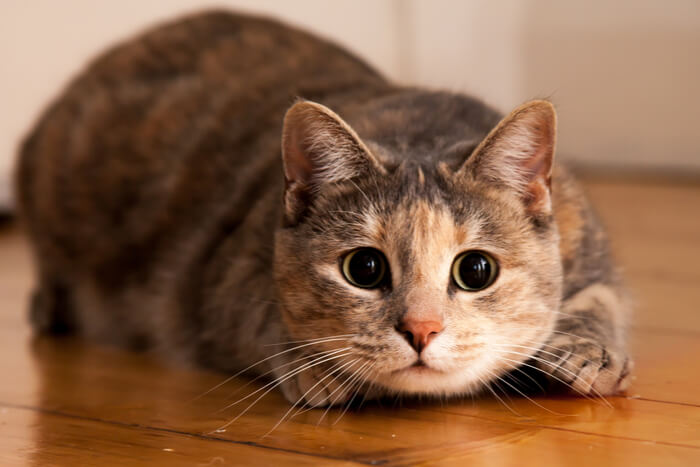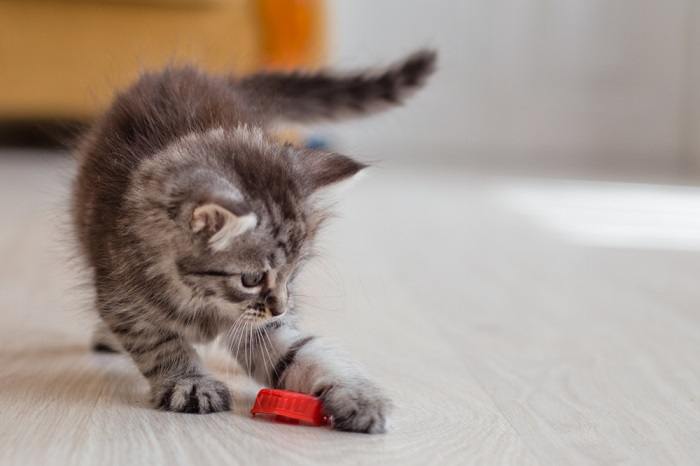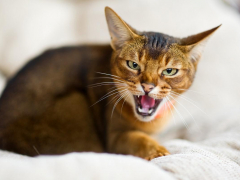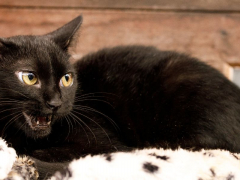
Do you have a cat who is a master crab walker? Or perhaps a pet who turns into a cat crab when startled? There are many reasons why your little cutie may be showing you their best crab walk.
Some cats crab walk in play, to practice motor skills, to get our attention, when experiencing the zoomies. Cats also crab walk when threatened or angry because turning their body sideways makes them look bigger to any potential threat. Occasionally, crab walking can be caused by a medical condition, such as neurological disorders, ear infections, or diabetes. Key Takeaways
They might be playing or practicing their movement skills, or on the other end of the spectrum, they might be defensive or angry, trying to scare off a potential threat. Some cats just perform this strange cat behavior when they get the zoomies! Which pattern does your cat fit? Read on to find out more!
1. Practice
Cats have strong hunting and survival instincts, and often spend time practicing various moves that they might need to make when out in the wider world. Even though most domestic cats have everything they could possibly need provided to them by their loving owners, instincts are still strong.
Cats and kittens may spend time practicing pouncing, chasing, grabbing, and biting motions, often as part of play. Being able to finely hone their survival skills—both hunting prey and avoiding potential predators—is an important need in cat behavior. The crab walk is used in various situations, including retreating quickly when startled, and your cat might practice this move at home in order to perfect it.
2. Play
If you share your home with a cat or kitten who is a naturally playful little being, you might be familiar with the cute crab walk. Cats use play in many ways: to practice certain behaviors and movements, to bond with other pets or people, and just to let off steam and have fun!
Your cat might engage in specific cat body language to invite a fellow cat—or you—to play with them. They might hop around you, crab walk, playfully pounce, or even go for the not-so-subtle approach of bringing you their favorite toy! A classic playtime move is for a cat to do the classic crab walk or hop sideways toward you, bringing a toy to present to you in a hopeful manner.
3. A Means of Defense
Cat behavior is complicated, and includes many types of communication, including scent, vocalization, and body language. When cats are faced with an opposing cat, a strange place, or any situation that gives them anxiety, they might employ various body postures to give off cues regarding their mood, and to make themselves appear intimidating in order to deter attack. A more overt sign of aggression such as a hiss or a pounce are only used as a last resort.
The crab walk is a useful tool for a cat in a strange situation, as it turns them side-on to any threat, making them appear bigger. Cats are fairly small mammals, and a sense of size is important when trying not to become prey! Cats will often puff up their fur and tails at the same time as changing their posture to also increase their apparent size and appear more threatening.
You might see your cat performing this crustacean-like movement if they are startled by another cat (even just seeing themselves in the mirror!) or if they perceive a threat of any kind. It might be accompanied by a big bushy tail, a weird growl type of vocalization, flattened back ears, and a wide-eyed staring gaze.
Wait, what? We’ve just talked about the crab walk as a sign of a happy, playful cat, and now we’re saying it’s a sign of defense or aggression? How do you know which is which? If your cat crab walks TOWARD you, with a little chirruping noise, a playful hopping motion, and perhaps a toy, this is a play invitation. If your cat is crab walking AWAY from something, with bushed-up fur, wide eyes, and a hiss or growl, this is a warning.
4. The Zoomies

Cats experiencing the zoomies use random movements, including the crab walk.
Zoomies, or frenetic random activity periods (FRAPs), are well known to most cat owners. Those funny five minutes or so where your cat acts as if it has just been launched from a space rocket, racing around your home or garden at full speed are mostly amusing, though they can be destructive if anything gets in your cat’s way!
The zoomies are mostly thought to be an expression of excitement and tend to be completely random movements, not directed at anything in particular, and really quite chaotic. Some cats will just run at full speed during the zoomies, but some will incorporate other movements such as that odd sideways crab walk.
5. Attention-Seeking
Cats can be loving and affectionate creatures and are often strongly bonded to their owners. Part of that bond usually involves them wanting your attention at all times, especially if you’re busy doing something. If your focus isn’t solely on your cat (the horror!), they might decide to grab your attention.
This might involve a meow, a tap on the hand with a sly paw, or perhaps a hopping crab walk! Each cat is individual and will ask for your fuss in different ways, but they are all just looking for some love.
6. Health Issues
A crab walk itself is not a specific sign of illness, but some medical problems can result in a lack of coordination in your cat’s movements.
Various neurological disorders can cause uncoordinated movements (ataxia) which can present as walking sideways, or in circles. Cerebellar hypoplasia in kittens, where the part of the brain involved in orientation and balance doesn’t develop well, can cause odd ways of moving in young cats. Diseases of the brain or spine can all present with strange movements as an early symptom.
Conditions affecting the vestibular apparatus, which controls balance, often present with a cat that is a bit wobbly when walking, sometimes also with a head tilt and a poor appetite or vomiting. Vestibular disease is often linked to infections in the middle or inner ear, which your veterinarian can investigate and prescribe treatment for.
Some other conditions, such as diabetes, can also cause weakness. If cats are very weak, they might struggle to walk well and perform odd movements such as crab walking.
If you are concerned that your cat may be unwell, contact your veterinarian.
Do All Cats Crab Walk?
Crab walking is very individual. Some cats are master crab walkers, performing this amusing motion often, and some will never do it at all. Kittens are more likely to crab walk, as they are generally more playful than adult cats, but even non-playful adults might use this sideways walk to deter potential threats.
How Should You Respond to a Crab-Walking Cat?
How you respond to a crab walking cat depends on the reason they are displaying the behavior. A cat that is clearly playful, hopping and crab walking at you, trying to get your attention, and bringing a toy, is clearly wanting to play. Indulging in some playtime with your cat is rewarding, and will lead to a strong bond between pet and owner.
A cat that is clearly worried or unhappy while crab walking is best provided with a safe place and then left alone to calm down. Cats like to be up high, so a safe hiding place above the ground is usually much appreciated by a startled or fearful cat. Cats usually try a defuse a situation before they resort to aggression, so allowing them some space and time to cool off is usually the safest approach.
As for the cat that’s crab walking during the zoomies—sit back and enjoy the amusing sight!
Also Read: 8 Ways To Help a Scared and Fearful Cat Be Confident
Final Thoughts

Cats crab walk to be playful, to practice their movement skills, to gain our attention, or whilst under the crazy influence of the zoomies.
If you see a cat walking sideways, it isn’t actually trying to impersonate a crab, despite appearances! Cats crab walk to be playful, to practice their movement skills, to gain our attention, or whilst under the crazy influence of the zoomies.
On the other side, they may do this odd sideways maneuver when threatened or angry, and some medical causes can cause similar symptoms. Does your cat have crustacean tendencies?!
Also Read: 11 Tips To Train Your Cat To Sleep All Night
Frequently Asked Questions
Why do cats do that weird sideways walk?
Cats perform the crab walk for many reasons, including playfulness, practicing their motor skills, garnering attention, or when they have the zoomies. Conversely, they may also do the sideways walk when they are scared or angry, or due to a medical cause.
Why do cats crab run?
If your cat hops and crab runs toward you, they be inviting you to play. If they perform the sideways hop away from you, particularly with a bushed-out tail, they are startled or fearful and need some space.
Why does my cat stare at me?
Cats use eye contact as a form of communication. A relaxed stare, with some slow blinks, is a sign of love and trust. A fixed stare with narrowed pupils is a direct challenge.








My cat will sometimes stand on one of my feet with her back paw why does she do that?
Generally, we assume this means that your cat feels affection for and some ownership of you, but the real reason may depend on the individual cat. Perhaps your cat wants your attention or would like you to stay in the same place. Keep an eye on when your cat does this and what she seems to be thinking or expressing in that moment—the answer may be more clear than you think!